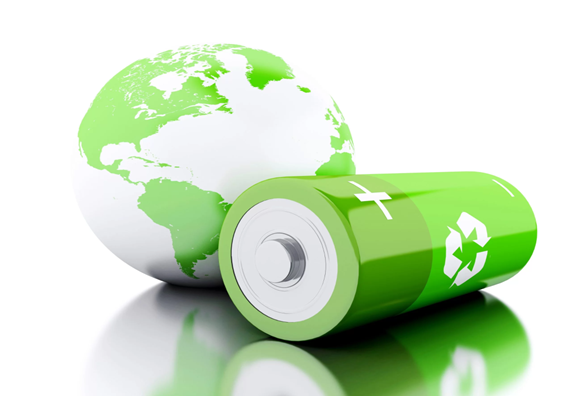In an era where sustainability has become a buzzword, the profound influence of lithium batteries on green initiatives stands out. They’re not just the heartbeat of our everyday gadgets; they’re also a beacon of hope for a greener planet. Through this extensive examination, you’ll unearth why these tiny powerhouses are more than just a battery – they’re a symbol of green transformation.

Why are Lithium Batteries Crucial for Green Initiatives?
Lithium batteries, often found in our smartphones and laptops, have risen as an invaluable ally in championing environmental causes. Before delving deeper, let’s clarify what they are: lithium batteries are a type of rechargeable battery where lithium ions move from the negative electrode to the positive electrode during discharge and back when charging.
Their compactness, efficiency, and longevity are precisely why they’re pivotal for sustainability. They support the development of technologies that reduce our carbon footprint, from electric cars to lithium batteries for medical equipment and devices. By cutting down our reliance on fossil fuels, they play a vital role in mitigating climate change.
How Do Lithium Batteries Work in Green Technology?
To fathom the green credentials of lithium batteries, we need to understand their structure and functioning. Below are the integral components and attributes that make these batteries the cornerstone of eco-friendly tech.
Anode: Typically made of graphite, it’s the battery’s negative electrode.
Cathode: Often composed of lithium metal oxide, it acts as the positive electrode.
Electrolyte: This liquid, or sometimes gel-like substance, facilitates the movement of lithium ions between the anode and cathode.
Separator: A crucial safety feature, it prevents the anode and cathode from coming into direct contact and causing a short circuit.
What are the core components of a lithium battery?
At the heart of every lithium battery lie its core components: the anode, cathode, electrolyte, and separator. The anode, usually graphite, releases lithium ions during discharge. The cathode, a lithium metal oxide, accepts these ions. The electrolyte allows ions to move between the anode and cathode, and the separator ensures they never touch, preventing potential hazards.
How is the energy storage capacity of lithium batteries enhancing green technologies?
The brilliance of lithium batteries lies in their remarkable energy storage potential. They can store significant amounts of energy in a compact space, ensuring devices and systems run efficiently for longer. This prowess translates to fewer charging cycles, reducing energy consumption and, consequently, carbon emissions. It’s this efficiency that makes them a linchpin in advancing sustainable tech.
What Businesses Benefit the Most from Lithium Batteries?
From homes to factories, lithium batteries are omnipresent. However, certain industries are particularly poised to reap their benefits:
Renewable Energy Sector: Storing wind and solar energy efficiently.
Automotive Industry: Powering electric vehicles for a greener commute.
Consumer Electronics: Enhancing the lifespan of gadgets, reducing e-waste.
Industrial Equipment and Automation: Ensuring machines run efficiently with fewer emissions.
Public Transport: Driving the transition towards electric buses and trains.
Renewable Energy Sector
The renewable energy sector, particularly solar and wind, hinges on effective energy storage. Here, lithium batteries shine by storing excess energy generated, ensuring a steady power supply even when the sun isn’t shining or the wind isn’t blowing.
Automotive Industry
The rise of electric vehicles (EVs) has been meteoric, thanks to lithium batteries. They not only ensure EVs have a competitive range but also play a part in reducing greenhouse gas emissions. As fossil fuel reserves deplete and environmental concerns amplify, the symbiotic relationship between EVs and lithium batteries will only strengthen.
Consumer Electronics
Our world is digitally driven. From smartphones to laptops, these gadgets are an integral part of our lives. Lithium batteries ensure these devices last longer, reducing the need for frequent replacements and, consequently, e-waste.
Industrial Equipment and Automation
In industries, machines need to run longer, faster, and more efficiently. Lithium batteries cater to this demand, ensuring equipment operates optimally while also being eco-friendly.
Public Transport
As cities grow, the need for sustainable public transport solutions escalates. Lithium batteries are at the forefront, powering electric buses and trains, offering a cleaner, quieter, and more efficient commute.
What Are the Economic Advantages for Businesses using Lithium Batteries?
Lithium batteries don’t just cater to ecological needs; they also significantly influence the financial facet of businesses. Here’s a snapshot of their economic value:
How do lithium batteries contribute to cost savings?
Lithium batteries are a prime example of ‘spend now to save later.’ Their energy efficiency translates to less frequent replacements, which means reduced operational costs. When used in products, their longevity can also be a selling point, leading to increased sales and customer loyalty. Moreover, their role in green initiatives can qualify businesses for tax incentives and rebates, further contributing to cost savings.
What is the impact of lithium batteries on operational efficiency?
Operational efficiency is paramount in today’s fast-paced business world. Lithium batteries, with their quick charging and longer discharge cycles, ensure that equipment, machinery, and electronics operate uninterrupted. This results in enhanced productivity, reduced downtimes, and ultimately, improved bottom lines.
How are Lithium Batteries Encouraging Cleaner Transport Solutions?
Transportation accounts for a significant chunk of global emissions. However, with the advent of lithium batteries, the narrative is gradually shifting. They’ve proven instrumental in the evolution of electric vehicles (EVs) and public transportation, offering a cleaner and more sustainable alternative to fossil fuel-driven transport.
What is the role of lithium batteries in Electric Vehicles (EVs)?
EVs are the torchbearers of sustainable transportation, and lithium batteries are the wind beneath their wings. These batteries provide EVs with the range, efficiency, and performance that rival, if not surpass, traditional vehicles. Moreover, as the technology advances, we can expect EVs with even better performance, all thanks to the evolving world of lithium batteries.
How are public transport systems evolving with lithium battery technology?
Cities worldwide are gradually recognizing the potential of battery-powered public transport. From electric buses in Los Angeles to battery-operated trams in Europe, the public transport landscape is undergoing a green transformation. Lithium batteries, with their quick charging and longevity, are making this transition smooth and efficient.
What is the environmental impact of transitioning to battery-powered transportation?
Switching to battery-powered transportation presents a twofold environmental benefit. Firstly, it significantly reduces the emissions from the transport sector, contributing to cleaner air. Secondly, by reducing the dependency on fossil fuels, it aids in the conservation of non-renewable resources and curtails the environmental damage associated with their extraction and usage.
How are Lithium Batteries Reducing Carbon Footprint in Energy Storage?
Lithium batteries have ushered in a revolution in energy storage, especially in harnessing renewable sources. Their contribution to a reduced carbon footprint is evident through:
Reduced Emissions: Efficient energy storage and consumption lead to less burning of fossil fuels.
Energy Efficiency: They allow efficient storage of renewable energy, ensuring a steady power supply.
Contribution to Reducing Global Carbon Levels: By facilitating a shift from non-renewable to renewable energy sources.
How do lithium batteries aid in harnessing renewable energy?
Renewable energy sources, like solar and wind, are intermittent. To harness their full potential, efficient energy storage systems are crucial. Lithium batteries, with their high energy density and longevity, offer the perfect solution. They store excess energy produced, ensuring its availability even when the renewable sources aren’t active.
What are the implications of lithium batteries for energy-dependent businesses?
For businesses that rely heavily on energy, be it manufacturing units or data centers, lithium batteries offer a reliable and efficient energy storage solution. They ensure uninterrupted operations, reducing downtimes and the associated losses. Moreover, their green credentials can enhance a company’s brand image, making them more appealing to the environmentally-conscious consumer.
What are the Safety Concerns and Solutions regarding Lithium Batteries?
While lithium batteries offer myriad advantages, they come with their set of challenges. Some of the primary safety concerns and their solutions are:
Overheating and Fire Risk: Ensure proper ventilation and avoid overcharging.
Leakage: Regular inspection and timely replacement can prevent this.
Environmental Concerns: Proper disposal and recycling methods can mitigate the environmental impact.
How can businesses ensure safe usage and storage?
Safe usage and storage of lithium batteries revolve around understanding their limitations and respecting them. This involves not overcharging them, ensuring they operate within specified temperature ranges, and storing them away from flammable materials. Regular inspections for signs of damage or wear can prevent potential hazards.
What are the disposal and recycling methods?
Given their environmental benefits, it’s ironic that improper disposal of lithium batteries can harm the environment. Thus, recycling and proper disposal are paramount. Many regions have specific drop-off points for used batteries. Additionally, some manufacturers and businesses offer take-back programs, ensuring these batteries are disposed of responsibly.
How Cost-effective are Lithium Batteries for Businesses in the Long Run?
While the initial cost of lithium batteries might be daunting for businesses, their long-term benefits are undeniable. They last longer, require less maintenance, and offer superior performance. When these factors are combined with potential tax benefits and rebates associated with green initiatives, the ROI becomes evident. Over time, businesses will find that these batteries are not just environmentally friendly but also economically prudent.
What are the factors influencing the price of lithium batteries?
The cost of lithium batteries is influenced by several factors, including the cost of raw materials, production technology, demand and supply dynamics, and advancements in battery technology. As research continues and technology advances, we can expect a gradual reduction in costs.
How does the longevity and efficiency of lithium batteries lead to ROI?
The longevity and efficiency of lithium batteries mean that they don’t need frequent replacements. This translates to significant savings over time. Moreover, their efficiency leads to reduced energy consumption, translating to lower operational costs. All these factors combined ensure a robust ROI for businesses.
Conclusion
Lithium batteries are more than just a technological marvel; they’re a symbol of the future – a future that is greener, sustainable, and responsible. As they continue to shape the contours of various industries, their role in fostering a better tomorrow becomes undeniably evident. For businesses, they are not just an investment in technology but an investment in the future.













